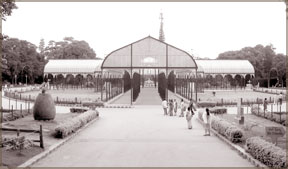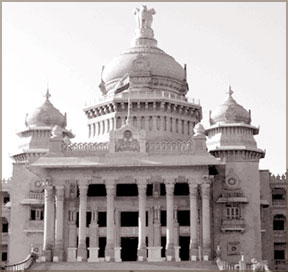City with a modern identity
If you've been in India a while, the capital of Karnataka will
probably feel like a long, soothing break from endless commotion. The
first city in India to get electricity, Bangalore continues, in many
ways, to blaze the trail in terms of the country's quest for a modern
identity.
Once known as the Garden City (and less encouragingly as Pensioner's
Paradise), the country's most pristine city evolved significantly when
the high-tech revolution arrived and Bangalore suddenly found itself at
the centre of the nation's massive computer hardware and software
industries.

Its cosmopolitan spirit fuelled as much by its lively bar and cafe
culture as by the influx of international business people, India's
high-tech hub has a high-energy buzz, yet it's tangibly calmer and
cleaner than most other places in the country, with far and away the
best climate of any Indian city - no doubt the reason the majority of
upwardly mobile Indians rank it the number-one city in which to live.
The city's real appeal is its zesty contemporary Indian lifestyle and
its usefulness as a base for getting to the extraordinary temples and
ruins of the Deccan interior and the vibrant cities of Hyderabad and
Mysore.
Hyderabad is the place of my nativity and Mumbai is currently my
adopted home. A good three summers of my life have been spent studying
at Bangalore and that's one city that I've always been enamoured of. A
lot has already been written about Bangalore from a tourist's point of
view - how to get there, where to stay, what to see, etc. I'll therefore
limit the scope of mine to analyzing whether it's really all hype and no
substance surrounding its status as the cradle of tech boom in India.

Over the last one decade or so, Bangalore has morphed from being just
a tourist getaway into the "Silicon Valley of India". It accounts for
more than 30% of India's IT software production and software exports,
which accounted for a minuscule Rs. 6 crores in 1991-92 have now
increased to more than Rs. 7400 crores in 2001.
Bangalore is also the home to many high-tech industries like Computer
Hardware/Software, Electronics and Telecommunications. Surely that kind
of industrial growth would not have been possible nor would so many MNCs
have sunk in millions of dollars to established bases without first
being convinced of the long-term benefits that it affords.
Bangalore is extremely well-planned and well-developed unlike its
more famous cousins across the country. The roads and buildings have
been built in a phased manner and cleanliness and greenery is a fetish
with the people. It might not have an airport of its own under the aegis
of Airports Authority of India but is that really an issue so long as
the city is well-connected by scores of flights to and from all corners
of the country?
The Karnataka Government, in collaboration with the Govt. of
Singapore established the STPI Complex and the Electronics City on the
outskirts of the city with all the required infrastructure and this
created the right climate to tempt MNC's to set shop in Bangalore.

Bangalore has always been known for its rich educational and cultural
milieu. It boasts of many leading engineering and scientific colleges
and research institutes in India.
When there is a great work atmosphere at the office and a relaxing
social life in the evenings to unwind, what more could one ask for?
Imagine, on the other hand, getting struck at a bus stop in New Delhi in
the middle of the night because there are not enough CNG busses on the
road or travelling precariously in an overcrowded local train for a
minimum of one hour in Mumbai and reaching home only to give the
impression to your folks that you've just come off from a street brawl!
While there is a very good percentage of English speaking population
in the city, it's difficult to come across someone who can't speak Hindi
unless one does PhD in it and speaks in a long extinct dialect. The city
also has a rich cultural diversity.
The layouts of the residential areas are often confusing with their
"crosses and streets" and the city bus drivers often drive like they are
in the midst of an F-1 race in the Monaco Grand Prix! Those are however
minor blemishes in a city which otherwise ranks right at the top among
the metros in India when charted on all the parameters that matter.
Bangalore was quick in identifying IT as a potential boom industry
and took steps to provide for its smooth development. It has been
offering the right infrastructure and other facilities required for
spawning a knowledge industry of this magnitude and the results are
there for all to see.
A city is only as good as its denizens are and I personally feel that
the Bangaloreans are a very helpful and pleasant lot. The pollution
levels are quite low when compared to other big cities, thanks mainly to
the abundance of green trees that dot both sides of the roads.
Considering all the above factors as also the fact that it continues
to grow steadily even after the dotcom bubble burst fortifies its claim
of truly being the "Silicon Valley of India".
What I like the best about Bangalore is the huge advertisement boards
in prominent places with the words "CONTACT SUJAY" written in bold on
them. I don't mind the free publicity but if only the ad firm was nice
enough to list my phone number below those two words, imagine the kind
of fan following I would be having on the distaff side by now:
From another point of view to the untutored eye, nothing seemed amiss
in the buzzing Friday night scene at I-Bar, a stylish night spot in the
Terence Conran-designed Park Hotel in Bangalore.
As a blue mosaic swimming pool glimmered outside the low-lit lounge's
glass doors, bartenders pressed glowing cocktails into manicured hands
while expatriate professionals compared notes on local food (properly
spicy) and broadband access (improperly slow).
To the sounds of American R & B spun by a D.J. behind a silvery
console, a large group of Indian women in tight jeans and high heels
began to gyrate on the dance floor. These are strange times in India's
fast-rising high-tech capital, whose abundance of bars and clubs have
earned it the moniker Pub City: a law enacted last June has effectively
banned dancing in bars and nightclubs and forces them to close by 11:30
p.m.
Though it was the first Indian city with electricity, according to
the Karnataka State government - and is now a global computer-industry
centre - Bangalore is still prone to power outages. And for an emerging
health-care hub whose large parks and warm climate have inspired the
nickname Pensioner's Paradise, many streets brim with garbage, standing
water and thick exhaust fumes - as well as goats, cows and people mired
in obvious poverty.
Yet as with the rebellious dancers at I-Bar, Bangalore's momentum and
determination are not easily dampened. "It has that spark, like Silicon
Valley in the 1990's," said Christian Misvaer, a Minneapolis native who
is starting a legal-process outsourcing venture in Bangalore.
Some of the new crop, like the boutique Cinnamon (where you can find
the latest fashions by the hot Indian designer Aki Narula), are blending
colourful Indian motifs and Western minimalism into a hybrid
Subcontinental cool. Others twist the twin strands of Bangalore's D.N.A.
- geek and chic - into concoctions like the "Restart" and "Reboot"
ayurvedic massage menus at the Park Hotel's spa. In fits and starts,
South Asia's techno-mecca is cultivating its inner South Beach.
On a Friday night in November, chauffeured cars dropped guests at
Bangalore's most Miami-esque hot spot, Olive Beach, a glittery new
restaurant cloistered in a compound ringed with imported sand. The
interiors, whitewashed and candlelit, exuded the airy elegance of a
millionaire's seaside villa. No surprise. One owner is an Indian pop
singer, Sagarika.
To attire themselves for the new generation of Bangalore hangouts,
the city's increasingly clothes-focused ranks have impressive choices.
As the newspaper Hindu observed, "Bangalore's young and happening
people, specifically the I.T. and professional crowd, have put the city
on the nation's fashion map.
" The city now has a Fashion Weekend in June, and throughout the
year, Indian designers preside over fashion shows at the majestic Leela
Palace hotel, whose indoor Galleria is Bangalore's answer to Rodeo
Drive.
For the most elite retail adventure, flag down an autorickshaw and
tell the driver, "Vithal Mallya Road." After buzzing noisily among the
other hornetlike black-and-yellow autorickshaws that swarm Bangalore's
streets, you'll be deposited along a pleasant tree-lined strip of
boutiques glowing with some of India's coolest creations.
The music in each boutique offers a clue to its wares. In Ritu Kumar,
strains of sitar complement the traditional, richly embroidered saris
and salwar-kameez outfits made by Ms. Kumar, the elder stateswoman of
Indian fashion who has dressed more than 20 Miss Indias.
At Ffolio, which represents some 20 top Indian designers, the groove
of the Red Hot Chili Peppers provides the soundtrack for racks of funky
threads that seem tailored for nightclubbing Rajasthani princesses.
Chicest of all are the minimalist white galleries in the Embassy
Classic building, a tranquil emporium of high-end clothing and home
decor bubbling with French electro music.
"They do stylish stuff that's Indian but with Western influence so
that you could still wear it back home," said Sam Pengilly, a
transplanted Londoner, as she admired elegant outfits adapted from
saris, swirly cocktail dresses and other threads in the adjoining
boutiques Balance and H2O.
They stock clothes from Indian designers like Rohit Bal and Rohit
Gandhi. "Here I can buy stuff and everyone at home is like 'Wow, where
did you get that?' " Ms. Pengilly said.
It's clear as soon as the weekend arrives that Pub City's sodden soul
hasn't been completely desiccated by the new night life restrictions.
From the panoramic outdoor terrace at the 13th Floor lounge to the hokey
space-shuttle interiors of NASA, the crowds mingle with their raspberry
martinis in one hand and Blackberry wireless devices in the other.
Cocktail culture appears in full swing.
In early November, in fact, travelling instructors from Lisbon's
International Cocktail Academy held workshops at bars, honing
bartenders' skills. Clearly Pub City isn't relinquishing its heavyweight
belt just yet.
At Taika, a sleek Asian-themed club with a menu of ayurvedic meals
and "spa drinks," a well-heeled international crowd was carrying the
belt especially high: it was dancing. Not crazily, not naughtily - but
enough to declare that those who labour under fluorescent tubes by day
should be allowed to shake their bodies under coloured lights by night.
As 11 p.m. passed and the Cinderella hour loomed, the D.J. slyly put
on a throbbing track whose refrain implored people, "Let's pump it up a
notch." And so they did, with help from Dr. Dre and Snoop Dogg. And
everyone headed to the floor.
(Website) |
